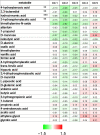Identification of Bacterial Metabolites Modulating Breast Cancer Cell Proliferation and Epithelial-Mesenchymal Transition
- PMID: 37570868
- PMCID: PMC10420980
- DOI: 10.3390/molecules28155898
Identification of Bacterial Metabolites Modulating Breast Cancer Cell Proliferation and Epithelial-Mesenchymal Transition
Abstract
Breast cancer patients are characterized by the oncobiotic transformation of multiple microbiome communities, including the gut microbiome. Oncobiotic transformation of the gut microbiome impairs the production of antineoplastic bacterial metabolites. The goal of this study was to identify bacterial metabolites with antineoplastic properties. We constructed a 30-member bacterial metabolite library and screened the library compounds for effects on cell proliferation and epithelial-mesenchymal transition. The metabolites were applied to 4T1 murine breast cancer cells in concentrations corresponding to the reference serum concentrations. However, yric acid, glycolic acid, d-mannitol, 2,3-butanediol, and trans-ferulic acid exerted cytostatic effects, and 3-hydroxyphenylacetic acid, 4-hydroxybenzoic acid, and vanillic acid exerted hyperproliferative effects. Furthermore, 3-hydroxyphenylacetic acid, 4-hydroxybenzoic acid, 2,3-butanediol, and hydrocinnamic acid inhibited epithelial-to-mesenchymal (EMT) transition. We identified redox sets among the metabolites (d-mannitol-d-mannose, 1-butanol-butyric acid, ethylene glycol-glycolic acid-oxalic acid), wherein only one partner within the set (d-mannitol, butyric acid, glycolic acid) possessed bioactivity in our system, suggesting that changes to the local redox potential may affect the bacterial secretome. Of the nine bioactive metabolites, 2,3-butanediol was the only compound with both cytostatic and anti-EMT properties.
Keywords: 2,3-butanediol; 3-hydroxyphenylacetic acid; 4-hydroxybenzoic acid; bacterial metabolite; breast cancer; butyric acid; d-mannitol; dysbiosis; epithelial-mesenchymal transition; glycolic acid; high content screening; hydrocinnamic acid; metabolite signaling; microbiome; proliferation; secretome; trans-ferulic acid; vanillic acid.
Conflict of interest statement
Bai is a shareholder and CEO of Holobiont Diagnostics Ltd., which are involved in the development of microbiome-based diagnostic tools. Other authors declare no conflict of interest.
Figures






Similar articles
-
Cytostatic Bacterial Metabolites Interfere with 5-Fluorouracil, Doxorubicin and Paclitaxel Efficiency in 4T1 Breast Cancer Cells.Molecules. 2024 Jun 27;29(13):3073. doi: 10.3390/molecules29133073. Molecules. 2024. PMID: 38999024 Free PMC article.
-
Indolepropionic Acid, a Metabolite of the Microbiome, Has Cytostatic Properties in Breast Cancer by Activating AHR and PXR Receptors and Inducing Oxidative Stress.Cancers (Basel). 2020 Aug 25;12(9):2411. doi: 10.3390/cancers12092411. Cancers (Basel). 2020. PMID: 32854297 Free PMC article.
-
The mechanism of action of Fangji Huangqi Decoction on epithelial-mesenchymal transition in breast cancer using high-throughput next-generation sequencing and network pharmacology.J Ethnopharmacol. 2022 Feb 10;284:114793. doi: 10.1016/j.jep.2021.114793. Epub 2021 Oct 30. J Ethnopharmacol. 2022. PMID: 34728317
-
The involvement of oncobiosis and bacterial metabolite signaling in metastasis formation in breast cancer.Cancer Metastasis Rev. 2021 Dec;40(4):1223-1249. doi: 10.1007/s10555-021-10013-3. Epub 2021 Dec 30. Cancer Metastasis Rev. 2021. PMID: 34967927 Free PMC article. Review.
-
Microbiome-Microbial Metabolome-Cancer Cell Interactions in Breast Cancer-Familiar, but Unexplored.Cells. 2019 Mar 29;8(4):293. doi: 10.3390/cells8040293. Cells. 2019. PMID: 30934972 Free PMC article. Review.
Cited by
-
Exploring the Role of the Gut and Intratumoral Microbiomes in Tumor Progression and Metastasis.Int J Mol Sci. 2023 Dec 6;24(24):17199. doi: 10.3390/ijms242417199. Int J Mol Sci. 2023. PMID: 38139030 Free PMC article. Review.
-
Multiomics insights on the onset, progression, and metastatic evolution of breast cancer.Front Oncol. 2023 Dec 19;13:1292046. doi: 10.3389/fonc.2023.1292046. eCollection 2023. Front Oncol. 2023. PMID: 38169859 Free PMC article. Review.
-
Integrated analysis of microbiota and gut microbial metabolites in blood for breast cancer.mSystems. 2024 Nov 19;9(11):e0064324. doi: 10.1128/msystems.00643-24. Epub 2024 Oct 18. mSystems. 2024. PMID: 39422470 Free PMC article.
-
Genetically predicted gut bacteria, circulating bacteria-associated metabolites and pancreatic ductal adenocarcinoma: a Mendelian randomisation study.Sci Rep. 2024 Oct 24;14(1):25144. doi: 10.1038/s41598-024-77431-5. Sci Rep. 2024. PMID: 39448785 Free PMC article.
-
Combination of Aspergillus niger culture and glycyrrhizic acid alleviates the toxic effects of multi-mycotoxins on broiler production performance and nutrient metabolism.Front Nutr. 2025 Jul 25;12:1628442. doi: 10.3389/fnut.2025.1628442. eCollection 2025. Front Nutr. 2025. PMID: 40786689 Free PMC article.
References
MeSH terms
Substances
Grants and funding
- K123975/National Research, Development and Innovation Office
- K124141/National Research, Development and Innovation Office
- FK128387/National Research, Development and Innovation Office
- TKP2021-EGA-19/National Research, Development and Innovation Office
- TKP2021-EGA-20/National Research, Development and Innovation Office
LinkOut - more resources
Full Text Sources
Medical

